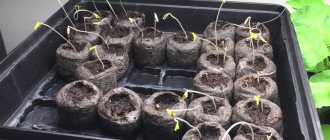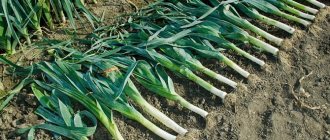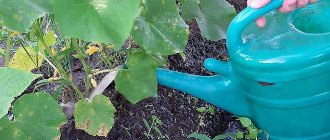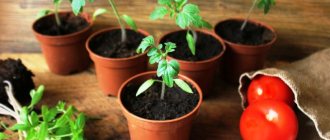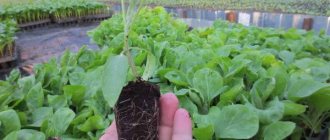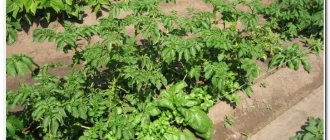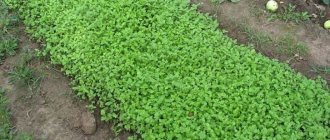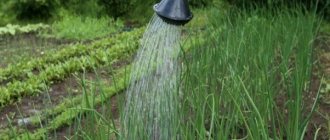If the gardener creates favorable conditions, then from the contents of just one bag of seeds he can get at least 3.5 kilograms of onions. Of course, in this case there are many variable conditions, starting from the integrity of the seed manufacturer. But one thing is clear: it is quite possible to obtain onions from nigella in one season in quantities necessary for consumption by an entire family.
There are basic agricultural techniques for growing vegetables. It comes down to the simplest scheme: sowing-picking-planting seedlings-care-harvesting. Of course, the chain of actions is also suitable for growing onions from nigella. However, in order to get a high-quality harvest, several factors must be taken into account.
How to check the germination of nigella onion seeds?
They quickly lose their high levels of this parameter. If it is planned to plant nigella onions in the spring, the buyer should check it himself. This is done like this:
- Wrap 20-30 seeds in cotton cloth, gauze or bandage, and secure with thread.
- Place the package in just boiled water and let it boil for 20-25 minutes. High temperatures contribute to the rupture of the seed coat by the roots. If this happens, they have good germination.
- To calculate the germination rate of nigella onion, you need to multiply the number of seeds with a torn shell by 100% and divide the result by the number of seeds being tested. A result of 75% or more is considered good germination.
How to prepare nigella onion seeds for sowing?
This stage is necessary for harvesting a good harvest in the future. When preparing nigella onions, the seeds require the following processing:
- Complete, large samples must be taken. Place them in warm water for 1-2 hours, stirring well. Small, empty seeds will float. Those remaining at the bottom are of high quality.
- Nigella onion needs disinfection. It can be susceptible to fungal and viral diseases, so before sowing they should be placed in a rich pink manganese solution for half an hour, placed in a bag of bandage or gauze. After the procedure, it is necessary to rinse the planting material using warm water.
- Disinfected seeds need to be warmed up. To do this, they need to be immersed in water at a temperature of 40-50°C for half an hour.
- After warming up, the planting material must be hardened by placing it in the refrigerator for half an hour. This is done to increase the adaptability of the seeds to any weather conditions.
- To obtain quick shoots, planting material is germinated. You need to place the seeds on a damp cloth or napkin, cover them with damp gauze or other cloth. After 7-10 days they will hatch. Then you need to plant them in moist soil, watering the rows until shoots appear. Nigella onions are seeds that do not sprout when placed in dry soil.
- To evenly distribute the planting material in a row, it is fixed with starch paste to toilet paper. When the paste dries, the pieces need to be rolled into a roll, and when sowing, unrolled and laid out in rows so that the seeds are at the bottom.
How to peel nigella onion seeds?
Manually sorting through each of them is an activity that requires time and effort, so the nigella onion for sets is peeled as follows:
- You need to gently knead it, and then put it in water and let it stand for a while.
- The husk will float to the surface of the water; it is removed with a spoon, gauze or hand. Peeled nigella sativum, from which the onion will grow healthy and give good seedlings, must be dried after cleaning.
- They also use another method of getting rid of the husks. Seeds are scattered in the wind by the handful. They are heavy, so the wind does not blow them away, but the husks fly off.
How to soak nigella onions before planting?
This is done to speed up seed germination. Everyone who is involved in this process is interested in how to grow large onions from nigella. Soaking helps achieve this result, and it is done like this:
- 4-5 days before sowing, the planting material should be placed in a fabric bag, filled halfway and tied.
- Place it in a container with water at room temperature. The liquid in which the nigella onion is soaked must be changed daily.
- Transfer the swollen seeds to a damp cloth or cloth and cover with the same material.
- After 2-3 days, white sprouts will hatch, which indicate that you need to dry the seeds and plant them.
How to sow nigella onions for sets?
It is necessary to pay attention to the soil in which the seeds will be planted. It should be nutritious, fertile, loose, and its acidity should be neutral. If nigella onions are used, growing them from seeds requires a properly carried out sowing process:
- For planting, it is necessary to prepare the soil, which includes turf soil, peat, sand, and humus.
- For sowing, you can use small plastic containers and glasses. They need to be filled with soil, the layer thickness is 7-8 cm.
- In order for planting nigella onions to be protected from infection by diseases, you need to treat the soil with Bordeaux mixture or a weakly concentrated solution of manganese.
- Using a blunt object, make shallow grooves at 5cm intervals.
- Using tweezers, the seeds are placed at a distance of 3 cm from each other. To distribute them evenly, a seeder for nigella onions can be used.
- Sprinkle the seeds with a thin layer of soil, which should be dry, using pressing and patting movements.
- Moisten the soil with a spray bottle.
- The containers should be covered with plastic wrap or a lid and removed to a warm place for germination.
- When the nigella onion produces loops, which will happen 3-7 days after sowing, the container should be placed on a well-lit windowsill. The ambient temperature should be 18-20°C. Condensation that appears on the lid must be removed daily.
Nigella onion on the head
You can grow a full-fledged vegetable in one season, but planting nigella onions must be of certain varieties. Large fruits are produced by salad varieties, for example Chalcedony or Exhibition. Other options may produce small vegetables, so there is no point in planting them. Rules for how a nigella onion sits on its head:
- You need to add superphosphate and wood ash to the beds, sprinkle with river sand, and then water with warm water.
- Seedlings are planted in the ground at a depth of 7-8 cm. The distance between rows should be 30-35 cm, between sprouts - 10 cm.
- It is necessary to mulch using peat and cover with lutrasil. The latter must be removed once the frosts have subsided.
Nigella onion on greens
This is done in open ground, when it warms up after winter frosts. Features of how to plant nigella onions in spring to obtain green feathers:
- Preparation of the beds should begin in the fall. They need to be dug up and fertilized with humus. In the spring, these steps need to be repeated. Acidic soil is treated with lime, and after two weeks you can start fertilizing it.
- Before sowing, the bed needs to be loosened and watered, but the moisture should not be excessive. It is necessary to disinfect the soil using copper sulfate.
- The seeds are laid out in rows, buried 1.5 cm. The distance between them should be 5 cm, and between the rows - 15 cm.
- The planting material must be covered with a thin layer of soil, and then watered using a sprayer.
Rules for planting seedlings in open ground
At the age of about 2 months, seedlings are usually ready to move to a permanent place. Usually it is planted by choosing a warm, dry day in the first ten days of May. Before transplanting, the plants are watered well, each of them is removed from the ground, inspected and sorted, removing weak and damaged specimens. Then the roots and green part are shortened by a third and dipped in a mash of clay and mullein with the addition of trichodermine.
Furrows are made in the bed, leaving 20–30 cm between them. The seedlings are placed in furrows at intervals of 8–10 cm, the bulbs are buried 2 cm, the row spacing is watered and mulched. The soil under the plantings is kept moist during the first week with periodic watering. Further care is no different from the usual care of onions grown from sets.
Experiment with growing onions from seeds.
Don’t neglect the opportunity to get full-fledged bulbs of the exact variety you like in one summer. But we can also recommend you planting onions before winter - this is an excellent original solution! Author of the article: Oksana Artemenko
How long does it take for nigella onion to sprout?
This process requires certain conditions. After how many days the nigella onion seeds germinate depends on the fulfillment of a number of requirements. The average period is 10-25 days. The optimal temperature for their growth is 16-18°C. It is important not to overheat them - a temperature of 30-35°C can be destructive. Planting material may not survive hypothermia. The critical temperature is -3°C.
How to speed up the germination of nigella onion seeds?
Even favorable conditions are not a guarantee that this process will occur in a short time. There are several ways to quickly germinate nigella onion seeds:
- Pour warm water into a 0.5 liter container and add 2 drops of Epin to it. Wrap the planting material in gauze and place it in the solution for a day. Remove the package from the product, squeeze it out, and place it in a plastic bag. You need to fill it with air, tie it, creating a tightness. You need to leave the seeds for 4-5 days, this time is enough for the nigella onion to hatch.
- Place the planting material in warm water, wrapping it in gauze. After 5 days, remove them and send them to a warm place. The gauze in which they are wrapped must be constantly damp. Sprouts will appear after 3 days.
- Brew a glass of strong black tea, add 1/2 teaspoon of soda to it. Wrap the seeds in a gauze bag and place them in the liquid for an hour. After extraction, transfer them to a humate solution for a day.
Why doesn't the nigella onion sprout?
There may be several reasons for this. Nigella onion seeds do not germinate if:
- Mistakes were made or stages of preparing planting material were missed.
- Incorrect care provided.
- Lack of normal conditions - non-compliance with temperature conditions and optimal humidity.
- If the germination of seeds has not been checked, there is no guarantee that it has been preserved and that the planting nigella onion will produce a good harvest.
- Using unprepared or inappropriate soil quality can cause low or no germination.
How to care for nigella onions after planting?
It is important to consider the following recommendations:
- Watering
. Nigella onion, its cultivation requires regular soil moisture. It needs to be watered 1-2 times a week. If the weather is dry, you need to do this more often. If there is no moisture, it will grow weak and small. In mid-July, watering should be completed so that the vegetables do not gain excessive amounts of moisture, due to which they will quickly deteriorate in the winter. - Weed control
. It begins with the appearance of sprouts. - Loosening the soil
. Nigella onions will give a poor harvest; if the soil dries out, a crust will form on it. Loosening helps avoid this. - Feeding
. The first time it is carried out after thinning using mullein infusion, which is diluted with water in a ratio of 1:10. Two weeks later, a second feeding is performed using potassium salt and superphosphate, taken 20 g each. - Fighting diseases
. One of the most common crop infections is fungal. To eliminate it, spray with “Fitosporin” once every 10-14 days. If the lesion is large-scale, Bordeaux mixture is used.
Planting nigella onions can also be affected by pests:
- Onion fly
. Signs of damage are plant feathers that have turned yellow and curled at the tips. To combat the pest, a saline solution is used, which is prepared at the rate of one pack of salt to 10 liters of water. The beds are sprayed with the liquid, and a couple of hours after treatment they need to be watered with clean water. - Mining moth
. The insect leaves white burrows on the stems. To combat it, insecticidal preparations are used - “Iskra”, “Dachnik”, “Metafos”. - Owl caterpillar
. The pest destroys the onion feather at the root and lives in the soil around the plant. It is removed manually, but you can also use such products as “Borey”, “Arrivo”, “Sherpa”.
Solving some problems
Onions practically do not attract pests at all for known reasons, but other types of problems may arise. Onion fly can turn onion leaves yellow ; special insecticides are used to avoid this effect.
Fungal diseases occur due to improper soil cultivation and high humidity. The fungus is combated using Bordeaux mixture. If agrotechnical recommendations are not followed, this leads to seedling failure.
The nigella onion is turning yellow - what to do?
If the plant has acquired an unhealthy color, measures are taken depending on the cause:
- Pests. They are controlled using insecticides. You can use a wide range of drugs - “Creotsid PRO”, “Confidor”, “Karbofos”.
- Sowing nigella onions in open ground can result in crop diseases - bacterial rot, rust. To combat, copper oxychloride is used, with which the plant is watered twice at intervals of a week.
- Nitrogen deficiency. In this case, you need to add rotted manure to the soil.
- Dry weather. If it causes the plant to turn yellow, you need to water it more often.
The best varieties
Among the many types of onions suitable for obtaining sets, popular annual mid-season and late-ripening ones are:
- Delight. The variety is classified as a late-ripening annual hybrid. Produces large bulbs of a bright yellow hue. The weight of the fruit reaches 150-300 g if sowing is carried out using seedlings. It is resistant to diseases and climatic conditions, suitable for long-term storage. The growing season ranges from 130 to 140 days.
- Centaur. The variety is an annual mid-season hybrid capable of growing in unfavorable conditions. Collected plants are subject to long-term storage. The growing season ranges from 90 to 110 days. The bulbs are dark yellow in color, round, weight – 100 g.
- Crimson ball. Large annual hybrid. The bulbs are dark purple in color. The taste is juicy and sweet. The feather is massive and strong. The weight of the fruit is 80-200 g. Suitable for fresh consumption. The growing season is 90 days.
See also: How can you feed onions to make them grow large?

